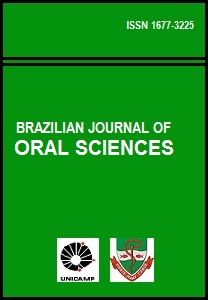Abstract
Ultrasonic and curette instrumentation produces a rougher root surface which could be influenced by working parameters such as instrumentation time, pressure and tip angulations. Thus, the aim of this in vitro study was to evaluate root roughness after ultrasonic instrumentation with different power settings and compared it to curette instrumentation. Ninety extracted human teeth were assigned to one of five groups: control group (without instrumentation), curette instrumentation, ultrasonic instrumentation with low, medium, and high power. Before and after instrumentation, surface roughness was measured with a profilometer and the surfaces were examined under the SEM. The mean roughness values of the treated roots were higher than the non-treated roots (0.40+0.08mm). Roots treated by ultrasonic instrumentation had higher roughness means than roots treated by curettes (1.120+0.241mm). Among ultrasonic groups, the higher power setting produced the higher roughness mean (1.58+0.23mm), which was significantly higher than the roughness obtained with the low power setting (1.39+0.18mm). These findings show that ultrasonic instrumentation with a high power setting produced a rougher root surface than ultrasonic instrumentation with a lower power setting. In addition, manual instrumentation with curettes produced lower roughness than ultrasonic instrumentation independent of power settingReferences
Cobb CM. Non-surgical pocket therapy: mechanical. Ann Periodontol. 1996; 1: 443-90.
Drisko CL, Cochran DL, Blieden T, Bouwsma OJ, Cohen RE, Damoulis P, et al. Research, Science and Therapy Committee of the American Academy of Periodontology. Position paper: sonic and ultrasonic scalers in periodontics. Research, Science and Therapy Committee of the American Academy of Periodontology. J Periodontol. 2000; 71: 1792-801.
Thornton S, Garnick J. Comparison of ultrasonic to hand instruments in the removal of subgingival plaque. J Periodontol.1982; 53: 35-7.
Chiew SY, Wilson M, Davies EH, Kieser JB. Assessment of ultrasonic debridement of calculus-associated periodontallyinvolved root surfaces by the limulus amoebocyte lysate assay. An in vitro study. J Clin Periodontol. 1991; 18: 240-4.
Smart GJ, Wilson M, Davies EH, Kieser JB. The assessment of ultrasonic root surface debridement by determination of residual endotoxin levels. J Clin Periodontol. 1990; 17: 174-8.
Leon LE, Vogel RI. A comparison of the effectiveness of hand scaling and ultrasonic debridement in furcations as evaluated by differential dark-field microscopy. J Periodontol.1987; 58: 86-94 7. Loos B, Nylund K, Claffey N, Egelberg J. Clinical effects of root debridement in molar and non-molar teeth. A 2-year follow-up. J Clin Periodontol. 1989; 16: 498-504.
Copulos TA, Low SB, Walker CB, Trebilcock YY, Hefti AF. Comparative analysis between a modified ultrasonic tip and hand instruments on clinical parameters of periodontal disease. J Periodontol.1993; 64: 694-700.
Laurell L, Pettersson B. Periodontal healing after treatment with either the Titan-S sonic scaler or hand instruments. Swed Dent J. 1988; 12: 187-92.
Kerry GJ. Roughness of root surfaces after use of ultrasonic instruments and hand curettes. J Periodontol. 1967; 38: 340-6.
Lie T, Leknes KN. Evaluation of the effect on root surfaces of air turbine scalers and ultrasonic instrumentation. J Periodontol. 1985; 56: 522-31.
Rosenberg RM, Ash MM Jr. The effect of root roughness on plaque accumulation and gingival inflammation. J Periodontol. 1974; 45: 146-50.
Lie T, Meyer K. Calculus removal and loss of tooth substance in response to different periodontal instruments. A scanning electron microscope study. J Clin Periodontol. 1977; 4: 250-62.
Jotikasthira NE, Lie T, Leknes KN. Comparative in vitro studies of sonic, ultrasonic and reciprocating scaling instruments. J Clin Periodontol. 1992; 19: 560-9.
Van Volkinburg JW, Green E, Armitage GC. The nature of root surfaces after curette, cavitron and alpha-sonic instrumentation. J Periodontal Res. 1976; 11: 374-81.
Benfenati MP, Montesani MT, Benfenati SP, Nathanson D. Scanning electron microscope: an SEM study of periodontally instrumented root surfaces, comparing sharp, dull, and damaged curettes and ultrasonic instruments. Int J Periodontics Restorative Dent. 1987; 7: 50-67.
Meyer K, Lie T. Root surface roughness in response to periodontal instrumentation studied by combined use of microroughness measurements and scanning electron microscopy. J Clin Periodontol. 1977; 4: 77-91.
Flemmig TF, Petersilka GJ, Mehl A, Hickel R, Klaiber B. The effect of working parameters on root substance removal using a piezoelectric ultrasonic scaler in vitro. J Clin Periodontol. 1998; 25: 158-63.
Kocher T, Langenbeck N, Rosin M, Benhardt O. Methodology of three-dimensional determination of root surface roughness. J Periodontal Res. 2002; 37: 125-31.
Schlageter L, Rateitschak-Pluss EM, Scchwarz JP. Root surface smoothness or roughness following open debridement. An in vivo study. J Clin Periodontol. 1996; 23: 460-4.
Flemmig TF, Petersilka GJ, Mehl A, Rudiger S, Hickel R, Klaiber B. Working parameters of a sonic scaler influencing root substance removal in vitro. Clin Oral Investig. 1997; 1: 55-60.
Chapple IL, Walmsley AD, Saxby MS, Moscrop H. Effect of instrument power setting during ultrasonic scaling upon treatment outcome. J Periodontol 1995; 66: 756-60.
Busslinger A, Lampe K, Beuchat M, Lehmann B. A comparative in vitro study of a magnetostrictive and a piezoelectric ultrasonic scaling instrument. J Clin Periodontol. 2001; 28: 642-9.
The Brazilian Journal of Oral Sciences uses the Creative Commons license (CC), thus preserving the integrity of the articles in an open access environment.

